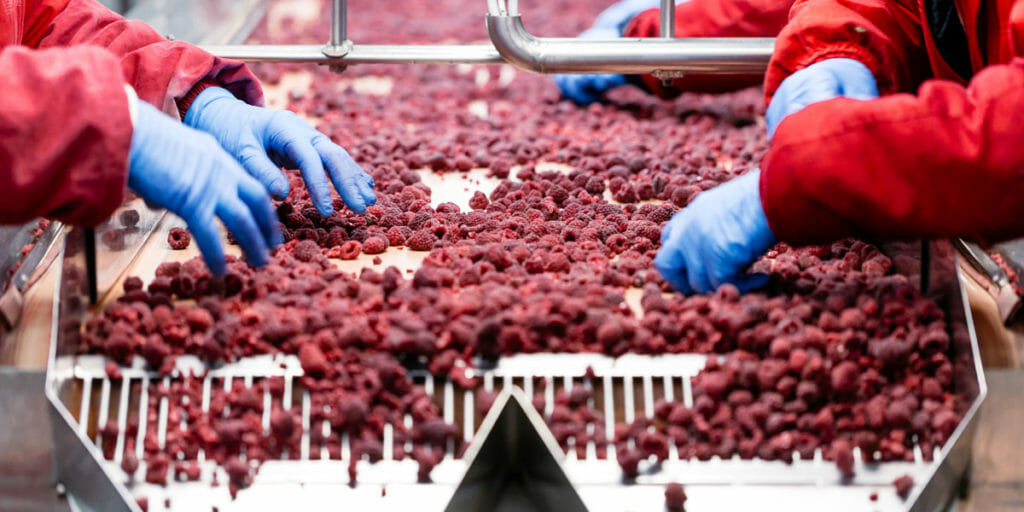Three high humidity problems food processors need to fix


High humidity in food processing is one thing processors don’t want. It’s the mastermind behind frost and condensation problems that can, at their worst, shut down plants.
Understanding the potential problems helps you proactively fight back against high humidity – critical when production levels need to be met and accidents can shut down a line.
“Most often, the moisture problem stems from the process,” said Dan Dettmers, an applications engineer at Quest who has spent more than 20 years helping food processors fix their humidity problems. “Maybe you’re boiling soup or the plant is producing more food at a faster rate than when the plant was designed.”
The problems caused by humidity generated by the production process often fall into three buckets that can have a huge impact on your operation.
Top Humidity Related Issues
- Food Quality
- Safety
- Regulatory Issues
Condensation + high humidity affect food quality
Ultimately, food quality and consistency are a processor’s top priorities and each can take a significant hit if humidity is an afterthought.
Much of the time, the process requires a specific moisture level. For example, whey powder will stick together if it’s too moist. Breading will clump or fall apart when moisture levels are too high or too low, respectively.
“There are a lot of products that require a certain level of relative humidity in the facility,” Dettmers said. “It depends on the process, many of which are significantly different than what the plant was originally designed for.”

Then there are quality issues such as sugar bloom. Humidity gets too high and the next thing you know a warehouse full of chocolate or frosting is ruined. This happens because water in the air draws sugar out of the product. When the water evaporates you’re left with a product that’s no longer fresh and looks equally as bad.
Then there’s frost. In plants, especially those that make foods such as frozen dinners, condensation from high humidity can shut down evaporators on blast freezers.
“If those evaporators get plugged full, you have to stop production,” Dettmers said. “And no one wants to stop.”
How high humidity hijacks safety
Few things create safety hazards in food-processing plants at the same rate as high humidity.
That’s because condensation often causes slick surfaces. One wrong step and an employee can be out of work for months, affecting staffing, increasing liability, and costing a company money.
“Safety is huge in food processing,” Dettmers said. “Plant operators are tuned into safety and slip-and-fall accidents need to be a top priority.”
Often, pipes begin to gather moisture, leading to nearly continuous drips that puddle unassumingly. Or, that moisture will gather under insulation, which results in corrosion that eats away at pipes. Corrosion leads to leaks of varying significance, from water to toxic ammonia, Dettmers said.
When it comes to frost, a host of safety problems exist. The most obvious is slick floors. But those floors affect more than employees walking through the facility.
In one facility I helped, they had a forklift hit a patch of ice. It went spinning out of control, product went flying. It was a disaster.
Doors also are affected by frost. Frost and condensation can block sight lines in windows, creating dangerous situations for forklift drivers
Regulate humidity. Avoid regulatory fines.
The worst-case scenario with humidity problems often involves a hefty fine or impending closure due to a regulatory violation.
Dettmers said many plant operators are starting to be proactive, fixing humidity issues before they become a liability.
“I think a lot of them are looking down the road and realizing it’s going to be scrutinized even more so than in the past,” he said.
Inspectors have specific red flags they’re always looking for when it comes to humidity-related problems.
What inspectors look for
- Staining
- Standing Water
- Draining
“Those are physical cues they’re looking for when walking through a facility doing an audit,” said Walt Waetjen, Quest’s Director of Product Development.
The simple fix: Desiccant dehumidifiers
In all these instances, facility operators often try a witch’s brew of solutions, when the answer is usually straightforward—Desiccant Dehumidifiers.
“Desiccant dehumidifiers can save you time and money if you work with the right partner,” Dettmers said. “I always walk through the entire problem with each customer to determine their needs. Often, we can work with what a processor has and then recommend a smaller, more cost effective dehumidifier, saving them money.”
For years, operators only used dehumidifiers as a last resort. This was due to the perception that they’re costly, and suppliers are difficult to work with, Dettmers said. That’s no longer the case. The focus is on providing simple, cost-effective humidity control options.
Dettmers, an engineer, works directly with contractors and processors to address the problem holistically, always looking for the simplest solution.
“The solution isn’t always just dehumidification, but when it is, I know I can go to them with a modular option previously not available, such as a Quest Trotec unit,” he said. “That means a facility can install a small unit, and if they need more humidity control, they simply upgrade that unit rather than buying a new one.”
Published on Aug 06 2019
Last Updated on Feb 16 2024
Categories: Cold Chain, Desiccants, Food & Beverage, Humidity
